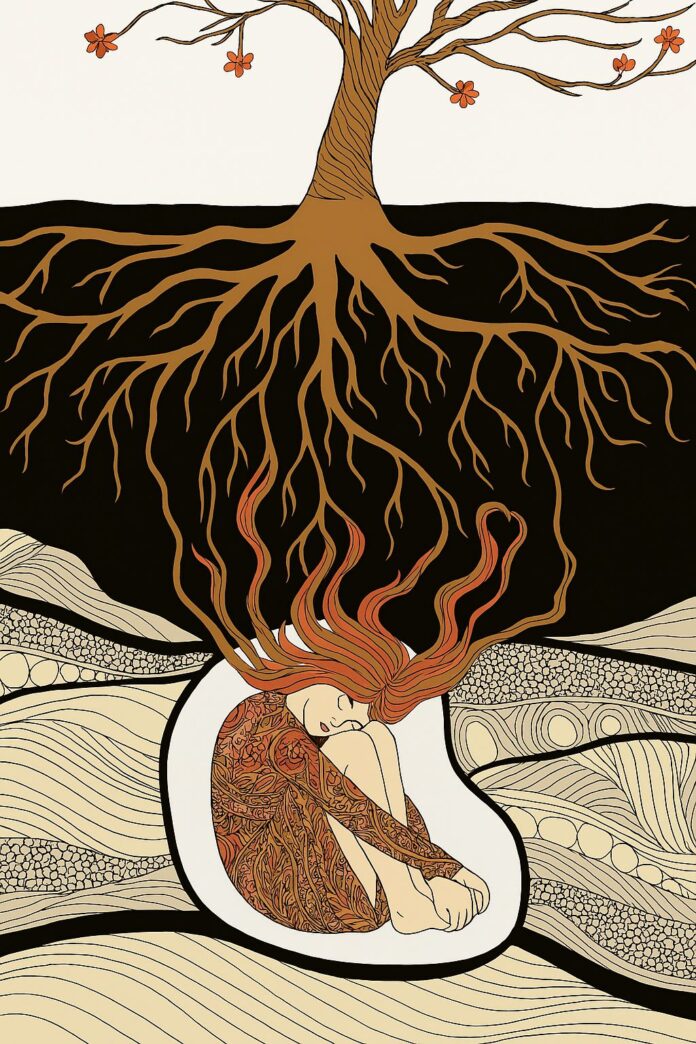In every myth, memory, molecule, and moment of spiritual awakening, the tree appears—not as ornament or observer—but as origin. It is the bearer of OM YUM HUNAB EMAHO, the sacred utterance of the One Giver of Movement and Measure. Through EVAM MAYA EMAHO, we hail the deep unity of mind and nature.
The Tree in the Physical Realm: Half Good, Half Evil
The world of formation, where form first emerges in the womb and the foetus is defined, is a realm of paradox:
-
Half Evil lies in the self-consciousness of the individual, bound by ego, separation, and the illusion of permanence.
-
Half Good manifests in emotional sensitivity—in the selfless, spontaneous joy we feel for another’s happiness.
To restore the half good, divine light and energy must re-enter our lives through nature, simplicity, and symbols that transcend language.
TREE: The Oversoul’s Living Symbol
The tree is more than metaphor. It is the axis mundi, the spiritual umbilicus through which all realms—heaven, earth, underworld—are connected. It speaks a language deeper than speech, a language of non-personal selfhood.
Across civilizations and cosmologies, the tree remains a sacred code:
-
Mesopotamia (3000 BCE): The cosmic tree links the heavens, earth, and underworld—a conduit of life and fertility.
-
Ancient Egypt: The acacia gives birth to Isis and Osiris—symbols of eternal life beneath the eye of Ra.
-
Celtic Mythology: Trees connect gods, humans, and ancestors; they balance the sacred triad of life, death, rebirth.
-
Norse Mythology: The great Yggdrasil, an ash tree, holds together the universe—its fate guarded by an eagle, dragon, and a whispering squirrel.
-
Shamanic Traditions: The tree is a ladder of realms, used in vision quests, chants, and healing rituals.
-
Hinduism & Buddhism: The Ashvatha tree in the Bhagavad Gita, with roots above and branches below, reflects our entanglement in material illusion fed by divine truth. The Bodhi Tree is the anchor of spiritual enlightenment.
-
Christianity & Islam: From Genesis to the Sidrat-al-Muntaha, the tree symbolizes our link to the divine source—sheltering prophets, demarcating realms.
Scientific Spirit: An Experiment with Naagpheni
In a humble scientific-spiritual study, the Naagpheni plant was placed in three unique homes:
-
An Office Space: The plant grew tall, echoing the physical stature of its owner. Here, the tree seemed to mirror the verticality of ambition and routine.
-
A House of Science and Spirit: Growth was holistic: in height, foliage, and thickness. Knowledge, both empirical and intuitive, fed the roots.
-
A Wiccan Priestess’s Home: The plant formed four living tunnels, symmetrical and rich with foliage. With resonance, chanting, and frequency alignment, the plant responded with a structured pattern, suggesting spiritual architecture within biological systems.
Epigenetics & the Subterranean Soul
To observe the underworld of trees is to unlock a library beneath our feet:
-
Taproots and adventitious roots,
-
Mycorrhizal fungi that connect forest after forest—tree after tree.
This underground matrix mimics neural networks, hinting at a vast sentient communication system—a biological internet of intention, emotion, and reaction. It raises fascinating questions in the realm of epigenetics:
-
Can spiritual practices influence gene expression, not just in individuals, but across interconnected lifeforms?
The tree, in this sense, becomes a living proof of interbeing.
Final Meditation: Listening to the Tree
To know the tree is to hear the Earth without ears, to see the universe with roots, to understand the self without name or form. The Tree of Being is not a thing—it is a frequency, a lawless law, a mirror of unity, eternally growing, remembering, and renewing.
In a world of fragmentation and noise, the tree calls us back to silence, rhythm, and resonance—back to the original pact between soul and soil.



